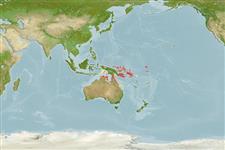>
Gobiiformes (Gobies) >
Gobiidae (Gobies) > Gobiinae
Etymology: Trimma: Greek, trimma, -atos = something crushed (Ref. 45335); meristum: Named for Christiane Waldrich, who photographed this fish; noun in the genitive case..
Environment: milieu / climate zone / depth range / distribution range
Ecologia
marinhas associadas(os) a recifes; intervalo de profundidade 0 - 7 m (Ref. 100726). Tropical; 1°S - 21°S, 14°E - 180°E (Ref. 100726)
Western Pacific: Australia (Great Barrier Reef), Papua New Guinea (Bismark Archipelago) and Fiji.
Tamanho / Peso / Idade
Maturity: Lm ? range ? - ? cm
Max length : 2.0 cm SL macho/indeterminado; (Ref. 119492)
Descrição breve
Morfologia | Morfometria
Espinhos dorsais (total): 7; Raios dorsais moles (total): 8; Espinhos anais 1; Raios anais moles: 7. This species is distinguished by the following characters: concave bony interorbital is less than half pupil-diameter in width; with a slight or no groove posterodorsal to the eye; scales in the midline of the predorsal 8-10; anal-fin rays 7; the fifth pelvic ray is branched twice dichotomously and subequal to the fourth in length, with a full basal membrane; the epaxial musculature reaches anteromedially to a point in line with the posterior margin of the pupil in adults; scale pockets on the head and body are strongly outlined by brown chromatophores (Ref. 100726).
Species collected from jetty pilings, log debris, and concrete stairs at the water’s edge, at about 1-4 meters. It apparently have an affinity for sponge-encrusted surfaces, but the general area where it is observed is characterized by extensive silty mud substrata inhabited by a large number of burrowing gobies. It was not previously observed despite nearly 100 hours of scuba-diving because the collection site is immediately adjacent to shore at a busy shipyard where diving is usually banned during daylight hours. Most of the specimens were found on the inner side of a single pillar of the jetty, which was situated in total shade (Ref. 119492).
Life cycle and mating behavior
Maturidade | Reprodução | Desova | Ovos | Fecundidade | Larvas
Winterbottom, R. and D.F. Hoese, 2015. A revision of the Australian species of Trimma (Actinopterygii, Gobiidae), with descriptions of six new species and redescriptions of twenty-three valid species. Zootaxa 3934(1):001-102. (Ref. 100726)
Categoria na Lista Vermelha da IUCN (Ref. 130435)
Ameaça para o homem
Harmless
Utilização humana
Mais informação
Nomes comunsSinónimosMetabolismoPredadoresEcotoxicologiaReproduçãoMaturidadeDesovaAgregação para desovaFecundidadeOvosDesenvolvimento dos ovos
Idade/TamanhoCrescimentoComprimento-pesoComprimento-comprimentoFrequência de comprimentoMorfometriaMorfologiaLarvasDinâmica larvarRecrutamentoAbundânciaBRUVS
ReferênciasAquaculturaPerfil para aquaculturaEstirpesGenéticaElectrophoresesHereditariedadeDoençasProcessamentoNutrientsMass conversion
ColaboradoresFotografiasStamps, Coins Misc.SonsCiguateraVelocidadeTipo de nataçãoÁrea branquialOutras referênciasCérebrosVisão
Ferramentas
Relatórios especiais
Descarregue XML
Fontes da internet
Estimates based on models
Phylogenetic diversity index (Ref.
82804): PD
50 = 0.5000 [Uniqueness, from 0.5 = low to 2.0 = high].
Bayesian length-weight: a=0.01023 (0.00477 - 0.02194), b=3.02 (2.84 - 3.20), in cm total length, based on LWR estimates for this (Sub)family-body shape (Ref.
93245).
Resiliência (Ref.
120179): Elevada, tempo mínimo de duplicação da população menor que 15 meses (Preliminary K or Fecundity.).
Fishing Vulnerability (Ref.
59153): Low vulnerability (10 of 100).
